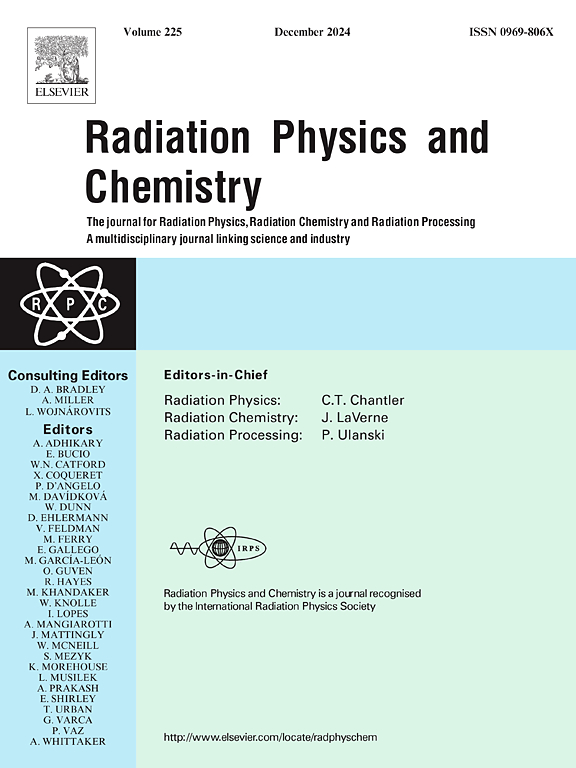利用质谱工具阐明辐射诱导的三苯甲烷芳香族染料分子碎裂
IF 2.8
3区 物理与天体物理
Q3 CHEMISTRY, PHYSICAL
引用次数: 0
摘要
本研究利用气相色谱-质谱法(GC-MS),通过检测辐照材料中低浓度产生的辐射诱导衍生物,研究了三苯基甲烷染料作为伽马辐射剂量计的潜力。原始三苯甲烷为染料的剂量测定特性建立了一个参考基线,以确定辐射合成衍生物的不同特征。在本研究中发现并量化的两种关键辐射诱导衍生物是 2-丙酮,1,1-二苯基-和二苯基甲醇苯甲醇,α,α-二苯基-,由于可能的天然化学或辐射过程,在原始材料中发现了微量的二苯基甲醇。伽马辐照大大加速了它们的形成,其相对浓度随着辐射剂量的增加而线性增加,最高可达 100 kGy。在较高的气相色谱保留时间内,观察到了不可避免的辐射诱导合成的低质量辐射片段;在研究范围内,这些片段也呈现出随剂量线性增加的趋势。本文章由计算机程序翻译,如有差异,请以英文原文为准。
Elucidation of radiation-induced molecular fragmentation in triphenylmethane aromatic dye using mass spectrometric tool
This study investigates the potential of triphenylmethane dye as a gamma radiation dosimeter using gas chromatography-mass spectrometry (GC–MS) through detection of radiation-induced derivatives produced at low concentrations in the irradiated material. Pristine triphenylmethane established a reference baseline for the dye’s dosimetric properties to establish a differentiated signature of the radiation-synthesized derivatives. The two key radiation-induced derivatives identified and quantified in the present work were 2-Propanone,1,1-diphenyl- and diphenylcarbinol Benzenemethanol, , -diphenyl- which was found in trace amounts in pristine material due to possible natural chemical or radiation processes. Gamma irradiation significantly accelerates their formation in which their relative concentration increases linearly with increasing radiation dose up to 100 kGy. Unavoidable radiation-induced synthesis of low-mass radiation fragments was observed at higher gas chromatography retention time; and also exhibit a linear increase with dose within the investigated range.
求助全文
通过发布文献求助,成功后即可免费获取论文全文。
去求助
来源期刊

Radiation Physics and Chemistry
化学-核科学技术
CiteScore
5.60
自引率
17.20%
发文量
574
审稿时长
12 weeks
期刊介绍:
Radiation Physics and Chemistry is a multidisciplinary journal that provides a medium for publication of substantial and original papers, reviews, and short communications which focus on research and developments involving ionizing radiation in radiation physics, radiation chemistry and radiation processing.
The journal aims to publish papers with significance to an international audience, containing substantial novelty and scientific impact. The Editors reserve the rights to reject, with or without external review, papers that do not meet these criteria. This could include papers that are very similar to previous publications, only with changed target substrates, employed materials, analyzed sites and experimental methods, report results without presenting new insights and/or hypothesis testing, or do not focus on the radiation effects.
 求助内容:
求助内容: 应助结果提醒方式:
应助结果提醒方式:


